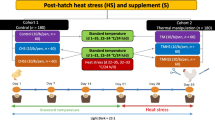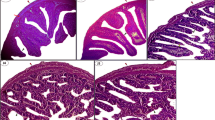Abstract
Environmental stress causes adverse effects in performance and antioxidant status of poultry. Dietary chromium supplementation promotes the growth rate and feed efficiency of growing poultry and these beneficial effects of chromium appear to be greater under stress. Biotin, a member of the vitamin B complex, is involved in the metabolism of carbohydrates, fats, and proteins. In a previous experiment, we examined the effects of chromium picolinate (CrPic) as a chromium source in birds subjected to high environmental temperature and the data showed that supplementation with CrPic ameliorated the deletorious effect of stress. The study was conducted to determine the effects of a supplementation of combination of CrPic and biotin (DiachromeTM) on performance, carcass characteristics, levels of oxidative stress markers, serum cholesterol, and glucose concentrations in Japanese quail (Coturnix coturnix japonica) exposed to high ambient temperature of 34°C. Two hundred forty Japanese quail (10 d old) were randomly assigned to 8 treatment groups consisting of 10 replicates of 3 birds. The birds were kept in a temperature-controlled room at 22°C (thermo-neutral [TN] groups) or 34°C (for 8h/d; 09.00 am to 05.00 pm; heat-stress [HS] groups). Birds were fed either a basal (control) diet (TN and HS) or the basal diet supplemented with either 1, 2 or 4 mg of Diachrome/kg of diet. Heat exposure decreased performance when the basal diet was fed (p=0.001). Diachrome supplementation increased feed intake (p=0.001), body weight (p=0.05), feed efficiency (p=0.01), and carcass traits (p≤0.05) variables linearly in birds reared under HS conditions. Serum vitamin C (p=0.05) and vitamin E (p=0.03) concentrations increased, whereas malondialdehyde (MDA) levels in serum and the liver (p=0.01), thigh muscle (p=0.05), and serum cholesterol and glucose concentrations (p=0.05) decreased in supplemented birds reared at a high temperature. It should be noted that when birds were kept at the thermo-neutral temperature, Diachrome supplementation did not affect (p>0.05) the variables measured, with the exception of a reduction in serum cholesterol and glucose. Results of the present study suggest that Diachrome can be considered a protective dietary supplement by reducing the negative effects of high environment temperature on performance and oxidative stress in quail.
Similar content being viewed by others
References
A. Marsden, T. R. Morris, and A. S. Cromarty, Effects of constant environmental temperatures on the performance of laving pullets, Br. Poult. Sci. 28, 361–380 (1987).
M. A. R. Howlider and S. P. Rose, Temperature and the growth of broilers, World's Poult. Sci. J. 43, 228–237 (1987).
S. Hurwitz, M. Weiselberg, U. Eisner, et al., The energy requirements and performance of growing chickens and turkeys as affected by environmental temperature, Poult. Sci. 59, 2290–2299 (1980).
NRC, The Role of Chromium in Animal Nutrition, National Academy Press, Washington, DC (1997).
J. S. Sands and M. O. Smith, Broilers in heat stress conditions: effects of dietary managanese proteinate or chromium picolinate supplementation, J. Appl. Poult. Res. 8, 280–287 (1999).
K. Sahin, M. Onderci, N. Sahin, and A. Aydin, Effects of dietary chromium picolinate and ascorbic acid supplementation on egg production, egg quality and some serum metabolities of laying hens reared under a low ambient temperature (6°C), Arch. Anim. Nutr. 56(1), 41–49 (2002).
K. Sahin, N. Sahin, M. Onderci, M. F. Gursu, and G. Cikim, Optimal dietary concentration of chromium for alleviating the effect of heat stress on growth, carcass qualities, and some serum metabolites of broiler chickens. Biol. Trace Element. Res. 89(1), 53–64 (2002).
N. Sahin, M. Onderci, and K. Sahin, Effects of dietary chromium and zinc on egg production, egg quality, and some blood metabolites of laying hens reared under low ambient temperature, Biol. Trace Element Res. 85(1), 47–58 (2002).
N. Sahin, K. Sahin, M. Onderci, M. Ozcelik, and M. O. Smith, In vivo antioxidant properties of vitamin E and chromium in cold-stressed Japanese qualis, Arch. Anim. Nutr. 57(3), 207–215 (2003).
R. A. Anderson, Chromium, in Trace Elements in Human and Animal Nutrition, Academic. New York, pp. 225–244 (1987).
D. D. Gallaher, A. S. Csallany, D. W. Shoeman, and J. M. Olson, Diabetes increases excretion of urinary malondehyde conjugates in rats, Lipids 28, 663–666 (1993).
H. G. Preuss, P. L. Grojec, S. Lieberman, and R. A. Anderson Effects of different chromium compounds on blood pressure and lipid peroxidation in spontaneously hypertensive rats, Clin. Nephrol. 47, 325–330 (1997).
S. Okado, H. Tsukada, and H. Ohba, Enhancement of nucleo RNA synthesis by chromium(III) in regenerating rat liver, J. Inorg. Biochem. 21, 113–119 (1984).
W. Mertz, E. W. Toepfer, E. E. Rogniski, and M. M. Polansky, Present knowledge of the role of chromium, Fed. Proc. 33, 2275–2280 (1974).
R. W. Rosebrough and N. C. Steele, Effects of supplemental dietary chromium or nicotinc acid on carbohydrate metabolism during basal, starvation, and refeeding periods in poults, Poult. Sci. 60, 407–417 (1981).
N. C. Steele and R. W. Rosebrought, Effect of trivalent chromium on hepatic lipogenesis by the turkey poult, Poult. Sci. 60, 617–622 (1981).
J. D. Pagan, S. G. Jackson, and S. E. Duren, The effect of chromium supplementation horses on metabolic response to exercise in thoroughbred, in Biotechnology in the Feed Industry: Proceedings of Alltech's Eleventh Annual Symposium, T. P. Lyons and K. A. Jacques, eds., Nottingham University Press, Nottingham, UK, pp. 249–256 (1995).
R. A. Anderson, Stress effects on chromium nutrition of humans and farm anmals, in Biotechnology in Feed Industry, T. P. Lyons and K. A. Jacques, eds., Nothingham University Press, Nothingam, UK, pp. 267–274 (1994).
A. J. Wright, D. N. Mowat, and B. A. Mallard, Supplemental chromium and bovine repsiratory disease vaccines for stressed feeder calves, Can. J. Anim. Sci. 74, 287–293 (1994).
D. N. Mowat, Organic chromium. A new nutrient for stressed animals, in Biotechnology in the Feed Industry: Proceedings of Alltech's Tenth Annual Symposium, T. P. Lyons and K. A. Jacques, eds., Nottingham University Press, Nottingham, UK, pp. 275–282 (1994).
K. Sahin, O. Kucuk, and N. Sahin, Effects of dietary chromium picolinate supplementation on performance, insulin and corticostrerone in laying hans under low ambient temperature, J. Anim. Physiol. Anim. Nutr. 85, 142–147 (2001).
L. R. McDowell, Vitamins in Animal Nutrition. Comparative Aspects to Human Nutrition. Biotin, L. R. McDowell, ed., Academic, London, chap. 11, pp. 275–297 (1989).
L. J. Machlin, Biotin, in Handbook of Vitamins, 2nd ed. revised and expanded, Marcel Dekker, New York, pp. 393–427 (1991).
J. R. Komorowski, J. De La Harpe, W. T. Cefalu, X. H. Zhang, Z. Q. Wang, and D. Greenberg, JCR:LA-cp rats show improved lipid profiles in response to diets containing chromium picolinate and biotin, Meeting of the Soceity for the Study of Ingestive Behaviour, University of Pennsylvania (Philadelphia), June 26–30, (2001).
Z. Q. Wang, X. H. Zhang, and W. T. Cefalu, Chromium picolinate and biotin enhance glycogen synthesis and glycogen synthase gene expression in human skeletal muscle culture, 17th International Diabetes Federation Congress, Mexico City, November 9, 2000.
N. R. C. Nutrition Requirements of Poultry. National Academy Press, Washington, DC. 1994
K. Sahin, N. Sahin, and O. Kucuk, Effects of dietary chromium and ascorbic acid supplementation on digestion of nutrients, serum antioxidant status and mineral concentratins in laying hens reared at a low ambient temperature, Biol. Trace Element Res. 87, 13–24 (2002).
AOAC, Official Methods of Analysis, 14th ed., Association of Agricultural Chemists. Arlington VA (1990).
SAS Institute, SAS ® User's Guide: Statistic. SAS Institute Inc., Cary, NC (1996).
A. Donkoh, Ambient temperature; a factor affecting performance and physiological response of broiler chickens, Int. J. Biometeorol. 33, 259–265 (1989).
R. E. Austic, Feeding poultry in hot and cold climates, in Stress Physiology in Livestock, Vol. 3, M. K. Yousef, ed., CRC, Boca Raton, FL, pp. 123–136 (1985).
P. A. Geraert, J. C. F. Padilha, and S. Guillaumin, Metabolic and endocrine changes induced by chronic heat exposure in broiler chickens: growth performance, body composition and energy retention, Br. J. Nutr. 75, 195–204 (1996).
J. S. Borel, T. C. Majerus, M. Polansky, P. B. Moser, and R. A. Anderson, Chromium intake and urinary chromium exretcion of trauma patients, Biol. Trace Element Res. 6, 317 (1984).
W. Mertz, Chromium in human nutrition: a review, J. Nutr. 123, 626–633 (1993).
R. J. Press, J. Geller, and G. W. Evans, The effect of chromium picolinate on serum cholesterol and apolipoprotein fractions in human subjects, West. J. Med. 152, 41–45 (1990).
T. Lien, S. Chen, S. Shiau, D. Froman, and C. Y. Hu, Chromium picolinate reduces laying hen serum and egg yolk cholesterol, Profess. Anim. Sci. 12, 77–80 (1996).
G. W. Evans, The effect of chromium picolinate on insulin controlled parameters in humans, Int. J. Biophys. Med. Res. 11, 163–180 (1989).
M. D. Lindemann, C. M. Wood, A. F. Harper, E. T. Kornegay, and R. A. Anderson, Dietary chromium picolinate additions improve gair: feed and carcass characteristics in growing finishing pigs and increase litter size in reproducing sows, J. Anim. Sci. 73, 457–465 (1995).
S. Okado, M. Suzuki, and H. Ohba, Enhancement of ribonucleic acid synthesis by chromium (III) in mouse liver, J. Inorg. Biochem. 19, 95–103 (1983).
J. B. Vincent, The bioinorganic chemisty of chromium (III), Polyhedron 20, 1–26 (2001).
M. F. McCarty, The case for supplemental chromium and a survey of clinical studies with chromium picolinate, J. Appl. Nutr. 43, 58–66 (1991).
K. L. Chen, T. F. Lien, and J. J. Lu, Effect of dietary chromium nicotinate on performance, serum traits and carcass characteristics of female turkeys, J. Biomass Energy Soc. China 17, 56–62 (1998).
T. F. Lien, Y. M. Horng, and K. H. Yang, Growth performance, serum haracteristics, carcass traits and lipid metabolism of broilers as affected by supplement of chromium picolinate, Br. Poult. Sci. 40, 205–211 (1999).
M. C. Linder, Nutrition and metabolism of the trade elements, in Nutritional Biochemistry and Metabolism with Clinical Applications, M. C. Linder, ed., Elsevier, New York. pp. 215–276 (1991).
M. A. Cupo and W. E. Donaldson, Chromium and vanadium effect on glucose metabolism and lipids synthesis in the chick, Poult. Sci. 66, 120–126 (1987).
Y. H. Km, I. K. Han, Y. J. Choi, I. S. Shin, B. J. Chae, and T. H. Kang, Effects of dietary levels of chromium picolinate on growth performance, carcass quality and serum traits in broiler chicks, Asian-Aust. J. Anim. Sci. 9, 341–347 (1996).
D. N. Brindley and A. M. Salter, Hormonal regulation of the hepatic low density lipoprotein: relationship with the secretion of very low density lipoprotein, J. Lipid Res. 30, 349–360 (1991).
K. Dakshinamurti and C. Cheah-Tan, Biotin-mediated synthesis of hepatic glucokinase in the rat, Arch. Biochem. Biophys. 127, 17–21 (1968).
D. C. Luadicina and L. J. Marnett, Enhancement of hydroperoxide-dependent lipid peroxidation in rat liver microsomes by ascorbic acid, Arch. Biochem. Biophys. 278, 73–80 (1990).
B. Halliwell and J. M. C. Gutteridge, Free radicals in Biology and Medicine, 2nd ed., Oxford University Press, New York (1989).
M. Onderci, N. Sahin, K. Sahin, and N. Kilic, Antioxidant properties of chromium and zinc. In vivo effects on digeastibility, lipid peroxidation, antioxidant vitamins, and some minerals under a low ambient temperature, Biol. Trace Element. Res. 92(2), 139–149 (2003).
B. Lambert and C. Jacquemin, Inhibition of epinephrine-induced lipolysis in isolated white adipocytes of aging rabbits by increased alpha-adrenergic responsiveness, J. Lipid Res. 20, 208–216 (1979).
A. S. Garfinkel, P. Nilsson-Ehle, and M. C. Schotz, Regula-tion of lipoprotein lipase induction by insulin, Biochem. Biophys. Acta 424, 264–269 (1976).
R. A. Anderson, M. M. Plansky, N. A. Bryden, and J. J. Canary, Supplemental-chromium effects on glucose, insulin, glucagon and uninary chromium losses in subjects consuming controlled low-chromium diets, Am. J. Clin. Nutr. 54, 909–916 (1991).
Author information
Authors and Affiliations
Rights and permissions
About this article
Cite this article
Onderci, M., Sahin, K., Sahin, N. et al. Effects of dietary combination of chromium and biotin on growth performance, carcass characteristics, and oxidative stress markers in heat-distressed Japanese quail. Biol Trace Elem Res 106, 165–176 (2005). https://doi.org/10.1385/BTER:106:2:165
Received:
Revised:
Accepted:
Issue Date:
DOI: https://doi.org/10.1385/BTER:106:2:165




